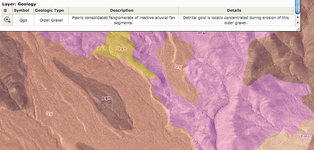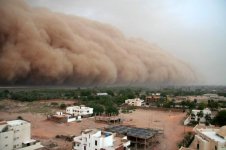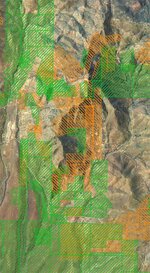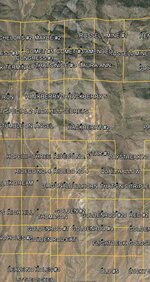I was writing this up to help Jeff (Goldenirishman) who is mining in the Gold Basin area. I figured I'd post it here to help anyone thinking of heading to that area.
The geology of the Gold Basin area is pretty interesting for the Geology student and should include a discussion of the Lost Basin/Garnet Mountain geology as well to help understand the groupings there. Since this is an effort to help a placer miner none of that really applies here (explained below) but if you have a further interest in the geology of this region you can find that information too in the referenced reports below.
The geology of the placer gold deposits in Gold Basin are really a story of the epic erosion of the local Colorado River Basin and the long term forming of the Grand Canyon more than any specific local geology that is identifiable today. The placer gold is found eroded and concentrated from the underlying ancient fanglomerates (dry mixed gravels) where they are exposed. These exposures are all within the valley portions of the basin, the mines (gold and otherwise) in the surrounding mountains have no direct connection with the placer deposits in the valley below.
It's often been observed that the best gold in Gold Basin occurs at particular elevations. Of course gold could care less what the elevation is but there is some truth to this observation about elevation. The degree of slope plays a part in the erosional process that first exposes and then concentrates the gold distributed through the older deeper gravels. Higher elevations generally have a greater slope and thus more erosion.
A more useful way to look for gold in the basin is to find where the older gravels are exposed and calculate where those exposed areas will concentrate their gold as they are eroded. With the resources below it is entirely possible to make fairly reliable estimates of where the concentrated gold areas will be found. Each exposure is on the maps in the reports. The older gold bearing gravels are labeled Qgo and the younger non-gold bearing gravels are labeled Qg on the maps.
We've already done that work graphically on our Gold Basin/Lost Basin Footprint map. The areas of gold bearing gravels that are exposed are clearly marked out. Computer Flood Modeling was calculated and added to the map to simulate the huge desert floods that occur every few lifetimes and actually move quite a bit of material. By combing those two factors you can roughly define the areas of greatest gold concentration.
To check this method of prediction we mapped the known historical placer producing areas and found that the predictions closely matched the known productive areas. That's all good but an even better test is to find an area that is predicted to have a gold concentration but has no known history of placer gold. In 2013 my friend Bunk, after defining an area of good potential with his FootPrint map, did indeed find a placer deposit and now has a claim there. Others have done so since.
In short - in Gold Basin find the old gravels and figure out where they concentrated their gold. All the info you need is in the reports below.
The fun part about Gold Basin is it's a relatively new and unexplored placer area. Miners didn't start working the placers there until the late 1930's and work has been light and sporadic ever since. Short of a hard trek in an unlikely area this is probably the closest most prospectors will get to the possibility of a big strike near civilization. As Jeff will tell you it's not all free beer and dancing girls but there is gold to be mined and it's pretty easy access.
None of this applies to Lost Basin/Meadview area. Different geology and different gold deposits just over the hill from Gold Basin. For Lost Basin the King Tut Mine is legendary and very large (pound +) nuggets are still found in that area every year or two. Maybe I'll find the time for that gold geology story another time.
Here are the resources, I think all of these can be downloaded from the Land Matters Geology Library.
Open File Report 75-93
Preliminary Geologic Map of the Garnet Mountain Quadrangle, Mohave Arizona
USGS Professional Paper 1361 and USGS PP 1361 Plate 1
Geology and Gold Mineralization of the Gold Basin - Lost Basin Mining Districts, Mohave County Arizona
Read the reports they have a lot of good information. You will need all the help you can get in tracking down these widely scattered placers. Until you understand how these particular placers are formed you can spend a lot of time on prospecting unproductive ground.
Heavy Pans
The geology of the Gold Basin area is pretty interesting for the Geology student and should include a discussion of the Lost Basin/Garnet Mountain geology as well to help understand the groupings there. Since this is an effort to help a placer miner none of that really applies here (explained below) but if you have a further interest in the geology of this region you can find that information too in the referenced reports below.
The geology of the placer gold deposits in Gold Basin are really a story of the epic erosion of the local Colorado River Basin and the long term forming of the Grand Canyon more than any specific local geology that is identifiable today. The placer gold is found eroded and concentrated from the underlying ancient fanglomerates (dry mixed gravels) where they are exposed. These exposures are all within the valley portions of the basin, the mines (gold and otherwise) in the surrounding mountains have no direct connection with the placer deposits in the valley below.
It's often been observed that the best gold in Gold Basin occurs at particular elevations. Of course gold could care less what the elevation is but there is some truth to this observation about elevation. The degree of slope plays a part in the erosional process that first exposes and then concentrates the gold distributed through the older deeper gravels. Higher elevations generally have a greater slope and thus more erosion.
A more useful way to look for gold in the basin is to find where the older gravels are exposed and calculate where those exposed areas will concentrate their gold as they are eroded. With the resources below it is entirely possible to make fairly reliable estimates of where the concentrated gold areas will be found. Each exposure is on the maps in the reports. The older gold bearing gravels are labeled Qgo and the younger non-gold bearing gravels are labeled Qg on the maps.
We've already done that work graphically on our Gold Basin/Lost Basin Footprint map. The areas of gold bearing gravels that are exposed are clearly marked out. Computer Flood Modeling was calculated and added to the map to simulate the huge desert floods that occur every few lifetimes and actually move quite a bit of material. By combing those two factors you can roughly define the areas of greatest gold concentration.
To check this method of prediction we mapped the known historical placer producing areas and found that the predictions closely matched the known productive areas. That's all good but an even better test is to find an area that is predicted to have a gold concentration but has no known history of placer gold. In 2013 my friend Bunk, after defining an area of good potential with his FootPrint map, did indeed find a placer deposit and now has a claim there. Others have done so since.
In short - in Gold Basin find the old gravels and figure out where they concentrated their gold. All the info you need is in the reports below.
The fun part about Gold Basin is it's a relatively new and unexplored placer area. Miners didn't start working the placers there until the late 1930's and work has been light and sporadic ever since. Short of a hard trek in an unlikely area this is probably the closest most prospectors will get to the possibility of a big strike near civilization. As Jeff will tell you it's not all free beer and dancing girls but there is gold to be mined and it's pretty easy access.
None of this applies to Lost Basin/Meadview area. Different geology and different gold deposits just over the hill from Gold Basin. For Lost Basin the King Tut Mine is legendary and very large (pound +) nuggets are still found in that area every year or two. Maybe I'll find the time for that gold geology story another time.

Here are the resources, I think all of these can be downloaded from the Land Matters Geology Library.
Open File Report 75-93
Preliminary Geologic Map of the Garnet Mountain Quadrangle, Mohave Arizona
USGS Professional Paper 1361 and USGS PP 1361 Plate 1
Geology and Gold Mineralization of the Gold Basin - Lost Basin Mining Districts, Mohave County Arizona
Read the reports they have a lot of good information. You will need all the help you can get in tracking down these widely scattered placers. Until you understand how these particular placers are formed you can spend a lot of time on prospecting unproductive ground.
Heavy Pans
Upvote
0



 ? You've done a ton of research, been to the county clerks, you have a pile of papers in your hand, and you still don't know where the
? You've done a ton of research, been to the county clerks, you have a pile of papers in your hand, and you still don't know where the
 ,
,

 Just the moving fine sands LOL
Just the moving fine sands LOL 




